
Discover Your Ancestors
Two critically acclaimed publications are available to family history researchers - the annual print magazine, Discover Your Ancestors, and the monthly online magazine, Discover Your Ancestors Periodical. Click here to subscribe.Trade Secrets
Apprenticeships have been a key part of many of our forebears' lives. Now there are more apprentice records searchable online than ever before.
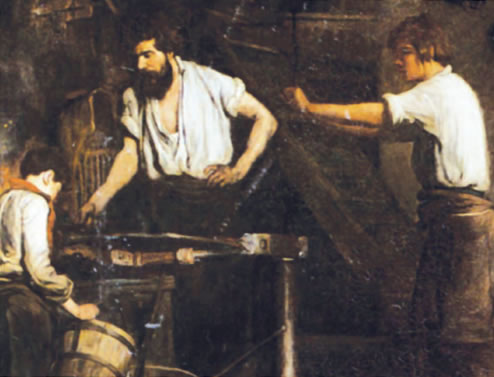 Apprenticeships have a long history, and had become very popular by the 14th century. To become an apprentice, the parents or guardians of the minor would speak with a guilds master craftsman to agree the conditions and price, which would then be recorded in an indenture. The apprentice would usually learn for 5-9 years, depending on the trade and the agreed contract. The typical apprenticeship lasted from age 14 to 21.
Apprenticeships have a long history, and had become very popular by the 14th century. To become an apprentice, the parents or guardians of the minor would speak with a guilds master craftsman to agree the conditions and price, which would then be recorded in an indenture. The apprentice would usually learn for 5-9 years, depending on the trade and the agreed contract. The typical apprenticeship lasted from age 14 to 21.
Records of apprenticeships in some cases date back to the 13th century when the trade guild system began, although many apprenticeships – such as those between fathers and sons – were inevitably never recorded.
From 1563, when the statute of Artificers and Apprentices was passed, it actually became illegal to enter a trade without undertaking an apprenticeship (although there were some exceptions).
From 1601, 'parish' apprenticeships under Elizabethan poor law came to be used as a way of providing for poor, illegitimate and orphaned children of both sexes alongside the regular system of skilled apprenticeships, which tended to provide for boys from slightly more affluent backgrounds. These parish apprenticeships, which could be created with the assent of two Justices of the Peace, supplied apprentices for occupations of lower status such as farm labouring, brickmaking and menial household service. Some records of these survive in local record offices.
The most useful set of apprenticeship records available to family historians, however, comes in the form of Stamp Duty records kept from 1710 to 1811.
These were registers kept by the Board of Stamps of the monies received in payment of the duty on apprentices' indentures under the Statute of Anne and subsequent acts.
In addition to the sums received, the registers record the names, addresses and trades of the masters, the names of the apprentices and the dates of the articles. Until the year 1752, the names of the apprentices' parents are typically given, but after that year very rarely.
These records are held by the National Archives at Kew in series IR1. The volumes consist of City or Town registers, October 1711 to January 1811, with daily entries of the indentures upon which duty was paid in London; Country Registers, May 1710 to September 1808 with entries, made in London, of the indentures upon which duty had been paid to district collectors and which were afterwards sent up by them in batches to be stamped; and a ledger of Duties Paid on Indentures, 1799 to 1802.
Where the Stamp Duty was paid in London, entries are in the city (town) registers. Where it was paid elsewhere, entries are in the country registers. If the apprenticeship was in Middlesex or one of the home counties the duty may have been paid in London and the details entered in one of the London registers.
The apprentice training route has for many people set them on their way in their working life or as a way of developing others. From James Hargreaves) inventor of the spinning jenny) to Thomas Yeoman (first President of The Society of Civil Engineers), to Sir Michael Caine (who started as an apprentice plumber) and Beatle George Harrison who was an apprentice electrician, they have all experienced the apprenticeship programme. Many apprentices did their training, worked their way up and then took on apprentices themselves.
This traditional way of training young people is now regaining popularity as the benefits our ancestors recognised are reintroduced as a way of giving people a start in a career.
Now leading data website TheGenealogist.co.uk has just released more one million apprentice and master records from the Stamp Duty registers. The site has also applied its advanced keyword search technology to census records of apprentices. These sources combined make more than two million searchable records – the largest searchable collection of apprentice records available online, covering the two centuries from 1710 to 1911.
The new records are available at www.TheGenealogist.co.uk to Diamond subscribers in the site's Master Search and under the 'Occupation Records' section. You can search for both apprentices and masters.
TheGenealogist allows you to view the full transcript of an apprenticeship record to see more details of your ancestors apprenticeship – including when they started their training , the 'master' who trained them and how long their apprenticeship was scheduled to be.
From 1710-1811 the master paid Stamp Duty for taking on the apprentice. The payment could be made at the start of the apprenticeship or any time up to one year after the expiry of the indenture. You might therefore need to search the records of several years' payments to find a particular entry.
The rate was 6d (sixpence) for every £1 under £50 which the master received for taking on the apprentice, and the rate of 1s (one shilling) for every £1 above £50. The indentures on which duty was payable cover Great Britain but not Ireland.
You may be able to find records for common trades such as weaving or other 18th century industries because:
The available apprenticeship records are nonetheless an invaluable tool for family historians, offering new avenues for research and helping you break down brick walls.
The Master Silversmith
Ayme Videau was a silversmith in the mid 18th Century, whose work can still be seen in art galleries today. With the new collection of apprenticeship records online at www.TheGenealogist.co.uk, you can search for both apprentices and masters. For example, we can see that Ayme Videau was an apprentice Goldsmith, and later took on two apprentices himself. Interestingly, when looking at the original images, his surname has been recorded as 'Vedeau' rather than 'Videau'.
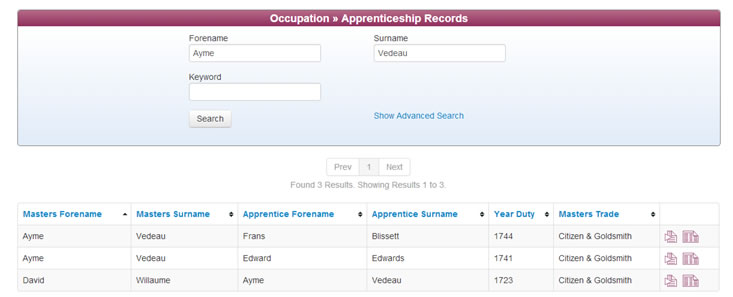

Ayme Videau in the apprenticeship records at TheGenealogist.co.uk
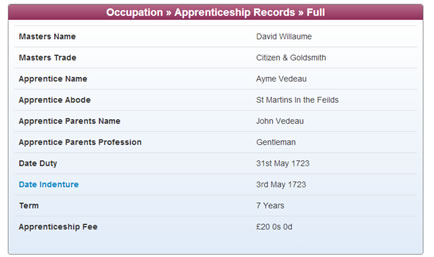
You can view the full transcript of an apprenticeship record to see more details. On the right, we can see where Ayme Videau lived, his father's name, his father's profession, the apprenticeship fee, and when the fee was paid.
Using the master search on TheGenealogist, we can see some more details about Videau's life.
We first searched using just his name, and immediately uncovered his will and marriage record. As well as a transcribed record of the will, you can also view the original will. His marriage was found in the Nonconformist records, and shows that he married Elizabeth Dexmier on 3rd May 1733.
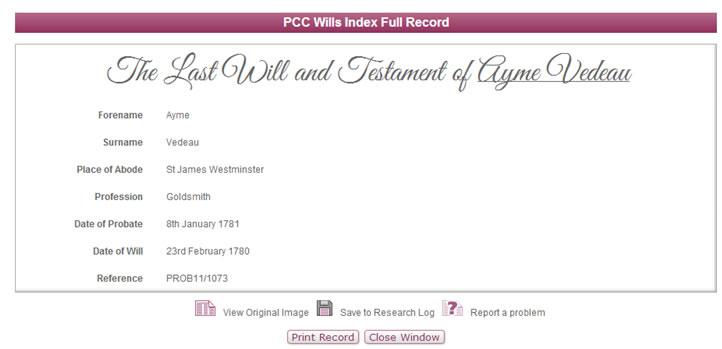
Ayme Videau's will
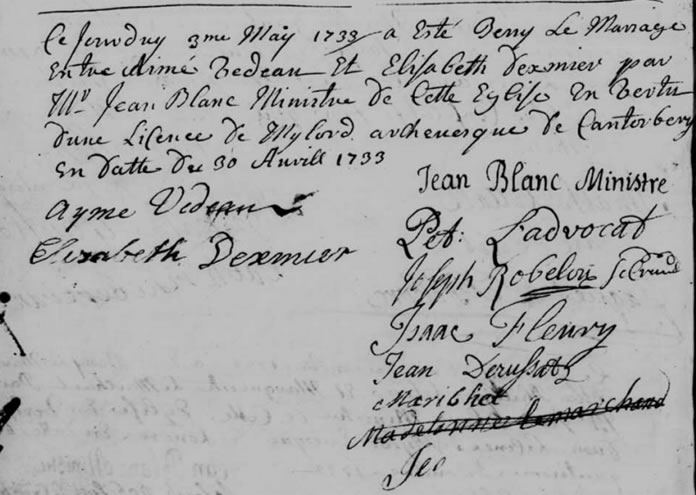
Ayme Videau and Elizabeth Dexmier's marriage record
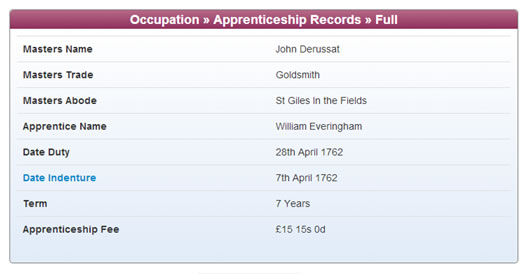
John Derussat in the apprenticeship records at TheGenealogist.co.uk
As you can see from the original marriage record (above), one of the witnesses was John Derussat, who was also a silversmith. He took on his own apprentice in 1762, as shown (right).